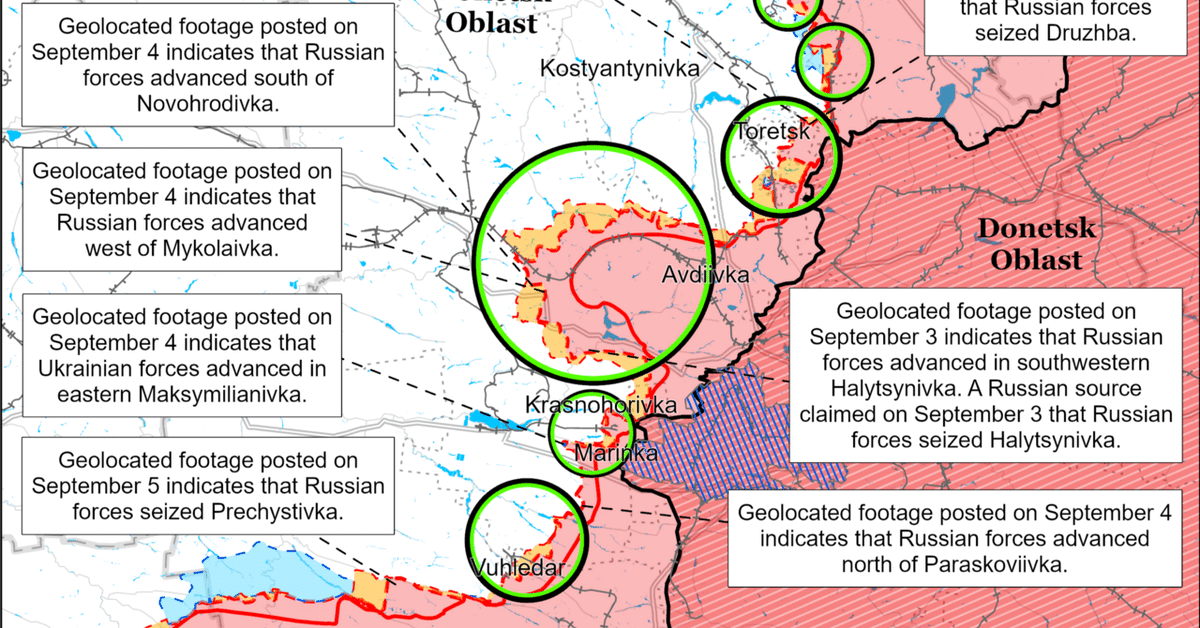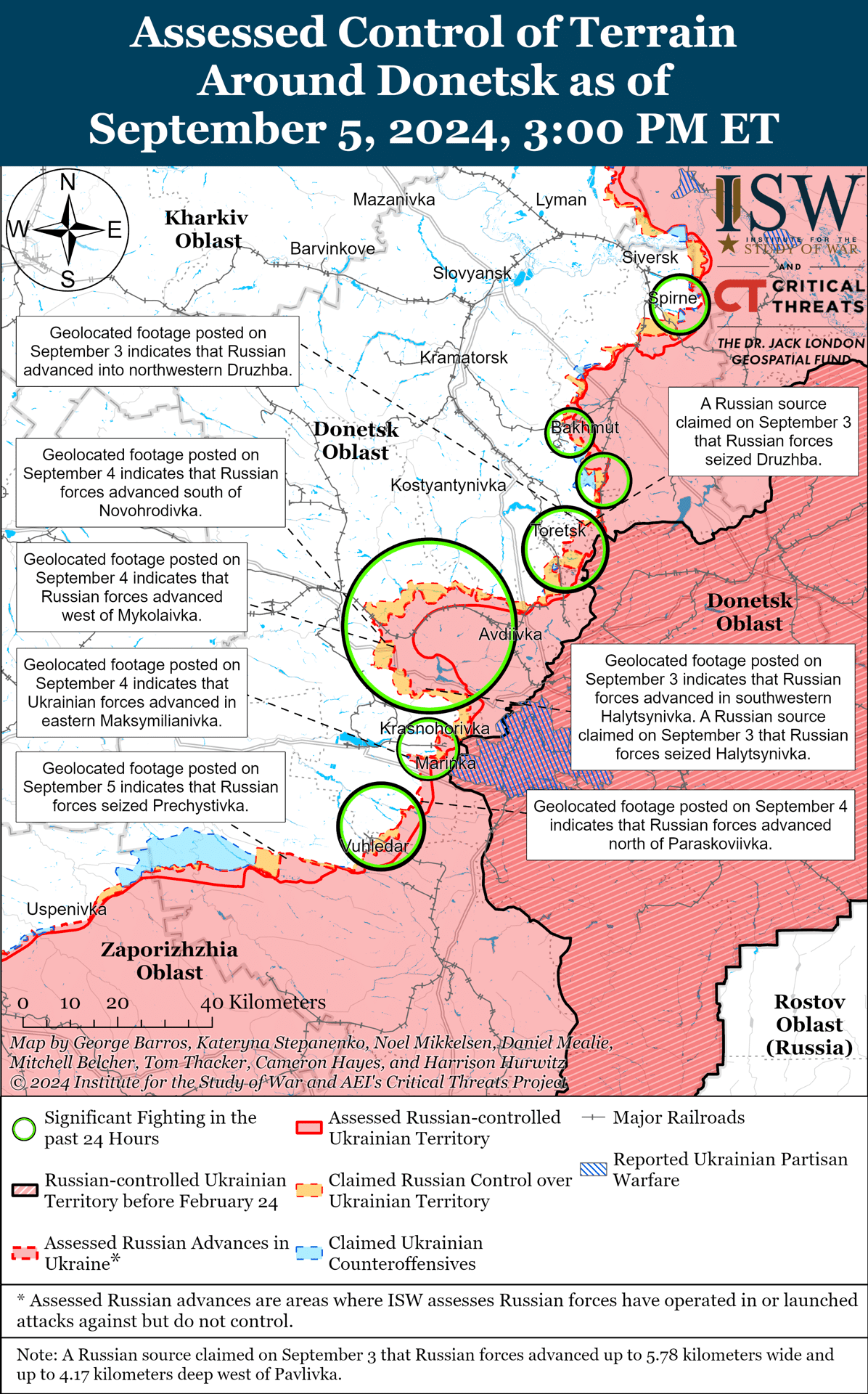
【抄訳】戦争研究所「ロシアによる攻勢戦役評価」2024.09.05 - ロシア軍ドネツィク攻勢の意図と今後の展開
Russian Offensive Campaign Assessment, September 5, 2024, ISW ⬇️
ロシア軍ドネツィク攻勢の意図と今後の展開
◆ 戦争研究所(ISW)報告書の一部日本語訳
ロシア軍は最近、以前から続けられている攻勢の取り組みを激化させており、その意図は、ドネツィク市から西と南西の方向に位置するウクライナ側大突出部を除去することと、H-15高速道路(ドネツィク市~ザポリッジャ市)まで到達し、この道路に沿って進むことにある。ポクロウシク[Pokrovsk]方面の南側面から、ヴフレダル[Vuhledar]周辺のウクライナ軍防衛戦力の西側面に至る地域で、連携して行われているようにみえるロシア軍攻勢作戦の目的が、ドネツィク州西部で防衛任務にあたるウクライナ軍に対する圧力を増すことと、ロシア軍にとって最優先とされるポクロウシク方面攻勢で、さらなる戦果をあげるための条件づくりを進めることにある。9月1日時点のことになるが、ロシア軍はヴフレダル周辺での攻勢作戦を、ここ最近、かなり激化させており、これまでのところ、この地域でわずかだが戦術レベルの戦果をあげている。9月5日に公開された動画のなかの撮影地点特定可能な画像によって、ロシア軍が最近、おおよそ1個中隊規模の機械化部隊による地上攻撃を行い、プレチスティウカ[Preschystivka](ヴフレダルから西方向)中心部内に進入したことが分かる。同じく撮影地点特定可能な画像を含む9月5日公開の別の動画には、ロシア軍第40海軍歩兵旅団(東部軍管区[EMD]・太平洋艦隊所属)に属する部隊が、プレチスティウカ北西部でロシア国旗を掲揚している様子が映っており、ロシア軍がすでにこの集落を奪取してしまっている可能性の高さが示されている。ロシア軍事ブロガーは、ウクライナ軍がゾロタ・ニウァ[Zolota Niva](プレチスティウカから西方向にすぐ)から撤退したと主張し、ロシア軍がこの地域で前進し続けていると主張した。9月5日に公開された動画のなかの撮影地点特定可能な画像によって、ロシア軍が最近、ヴフレダルから東方向のピウデンノドンバスカ[Pivdennodonbaska]第1鉱床付近で前進したことが分かる。公開情報を扱うウクライナのアカウントの一つが、さらに別の動画を公開したが、そこには、ここ最近の数日間でマカリウカ[Makarivka](ヴェリカ・ノヴォシルカ[Velyka Novosilka]から南の方向、ヴフレダルから西の方向)付近とプレチスティウカで、小隊規模の機械化部隊攻撃を複数回行うロシア軍が映っている。このウクライナのアカウントによると、マカリウカ付近で攻撃を行ったロシア軍部隊は、第60自動車化狙撃旅団(EMD・第5諸兵科連合軍[CAA]所属)、第394自動車化狙撃連隊(EMD・第5CAA所属第127自動車化狙撃師団隷下)、第218戦車連隊(EMD・第5CAA所属第127自動車化狙撃師団隷下)の各隷下部隊であるとのことで、プレチスティウカ付近で攻撃中なのは、第40海軍歩兵旅団、第5戦車旅団(EMD・第36CAA所属)、第37自動車化狙撃旅団(EMD・第36CAA所属)、第430自動車化狙撃連隊(おそらく動員された部隊の一つ)の各隷下部隊であるとのことだ。ロシアのウラジーミル・プーチン大統領は沿海地方ウラジオストクで開催された東方経済フォーラムで9月5日に行ったスピーチにおいて、上述の地域でロシア軍攻勢作戦が激化していることを認め、ロシア軍東部部隊集団(だいたいヴフレダルからフリャイポレ[Hulyaipole]までを担当戦域としている)が9月3日に縦深5~7キロメートル範囲の「三角形上の」地帯を掌握したと主張した。

米国東部時間2024年9月5日午後3時の時点
(戦争研究所)
ロシア軍はドネツィク市の南西と西の方向に位置するほかの場所でも、比較的高烈度な攻勢作戦を行っている。そして、ヴフレダル付近でのロシア軍攻勢作戦の激化が、短期的にみて、ドネツィク州西部のほかの場所で行われているロシア軍攻勢のテンポ低下の兆候になる可能性は低い。ドネツィク市から南西方向の地点で行動しているウクライナ軍空挺旅団の一つは9月4日に、コスチャンティニウカ[Kostyantynivka]付近で戦車4両と装甲戦闘車両17両を含む増強中隊規模のロシア軍機械化部隊による攻撃を撃退するウクライナ軍を撮影した動画を公開した。ロシア軍は2024年7月末に、ドネツィク市から西と南西の方向における機械化部隊攻撃の規模とその頻度を増加させた。そして、それ以降、この地域で比較的大規模な機械化部隊攻撃の遂行を続けている。だが一方で、これらの地上攻撃の成果は、わずかな戦術レベルでの領土占領にとどまっている。ロシア軍はまず7月末に、ドネツィク市から南西方向の地点で攻勢作戦を激化させた模様で、その目的は、O-0532高速道路(コスチャンティニウカ~ヴフレダル)の遮断という以前からの戦術目標を達成することにあった。だが、この目標を達成したのちも、この地域で大規模な機械化部隊攻撃を続いている。ポクロウシク方面で戦果を拡張する取り組みをロシア軍は激化させており、また、ウクライナ軍のクルスク州進攻に対応してロシア軍は部隊配置転換を行っているけれども、これらのことが、ドネツィク市から西と南西の方向でのロシア軍攻勢のテンポを混乱させている様子は今のところない。ロシア軍が大規模かつ損害の大きい機械化部隊攻撃を継続していることは、ロシア軍統帥部が上述の地域に展開している東部部隊集団と南部部隊集団の双方に、もっと大きな作戦レベルの目標を任務として与えていることを示唆している。
ロシア軍がポクロウシク突出部の南側面を広げ始めた直後に、同軍はヴフレダル付近での攻勢作戦を激化させた。このことが示唆しているのは、ロシア軍が、ポクロウシク方面の南翼沿い、ドネツィク市のすぐ西方、O-0532高速道路沿い、ヴフレダル付近において、相互に補強し合うかたちでの攻勢作戦を遂行する意図を有しているということだ。ロシア軍は2024年8月末にポクロウシクから南東の方向に位置するセリドヴェ[Selydove]~ウクラインシク[Ukrainsk]~ヒルニク[Hyrnyk]線上で、唐突な戦術行動を開始した。その目的は、ポクロウシク方面で形成されたロシア側突出部の範囲を広げ、この突出部のウクライナ軍反撃に対する脆弱性を取り除くことにある。ロシア軍はすでにポクロウシク突出部の南側地区を部分的に拡張することに成功しており、ヒルニクから東方向とクラスノホリウカ[Krasnohorivka]から北方向に広がる田園的な野外エリアに存在する、限られた数のウクライナ軍陣地を戦術的に包囲する取り組みを、現在、続けている。各種情報によると、ロシア軍はウクラインシク郊外に達しており、ヒルニク郊外に接近中であるとのことだ。そして、この二つの町が占領されれば、ロシア軍はクラホヴェ[Kurakhove]を北から攻撃できるようになり、それと並行して、クラスノホリウカとマクシミリヤニウカ[Maksymilyanivka]を起点に東方からも攻撃できるようになる。なお、クラホヴェという町は、ドネツィク市から西と南西に位置する前線にとって極めて重要なウクライナ軍防衛拠点である。ロシア軍が東側面でクラホヴェに接近するなかで、同軍がヴフレダル付近で攻撃を激化させていることには、ドネツィク市から西と南西の方向に位置するエリアに展開するウクライナ側防衛戦力の西側面に圧力をかける意図が含まれている可能性が高い。O-0532高速道路上のコスチャンティニウカ~ヴフレダル区間でロシア軍が攻勢作戦を行うことは、ロシア軍に進撃路を提供することになり、その進撃路は、そこから北へ向かってクラホヴェを制圧する取り組みと、西に向かってヴフレダルを包囲・制圧するロシア軍の取り組みの両方を支援できるだろう。ロシア軍は2022~2023年の冬季にドネツィク州西部で攻勢を仕掛け、それに失敗した。そのときの攻撃として有名なのは、ヴフレダルの町自体に向けた機械化部隊による大規模な正面突撃である。しかし、ロシア軍は現在、相互支援関係にある複数の進撃軸での漸進的な前進を追及している模様だ。このようなロシア軍の作戦計画は、同軍が機械化機動戦による作戦レベルの大突破を試みることを放棄するなか、ますますよく見られるものになっている。
ロシア軍統帥部はクラホヴェとヴフレダルの奪取を目指しており、そうすることでロシア軍がH-15高速道路に達し、この高速道路に沿って、もっと迅速に戦術的な戦果をあげることを目指している可能性が高い。だが、この二つの集落を制圧できても、ドネツィク州西部に広がるウクライナ側突出部を除去する目的で、この二集落の占領を活用する点で、ロシア軍が困難に直面することになる可能性は高い。ロシア軍がヴフレダルを制圧できた場合、南からH-15高速道路に向かおうとするロシア軍の取り組みを防ぐ目的で、ウクライナ軍が今までうまく活用してきた強化防御陣地は、取り除かれてしまうことになる。けれどもヴフレダル占領は、ロシア軍がH-15高速道路に到達できるかどうかにとっての決定的な要因にはならないだろう。ヴフレダルはH-15高速道路から南方に23キロメートル離れた場所にあり、ヴフレダルと高速道路の間は、おもに開けた野外地域である。このような地域でより一層迅速な戦術的戦果をあげるには、巧妙な機械化部隊による攻撃を行う必要がロシア軍に生じる。ドネツィク市から西と南西の方向で、7月末以降、激しく行われたロシア軍の機械化部隊攻撃は、今までのところ、たかだか数キロメートル程度の前進を促進してきたにすぎない。そして、ロシア軍はこれまでずっと、作戦レベルで機械化機動戦を効果的に遂行するという点で無能であることを示している。ロシア軍が目指すクラホヴェ占領が成功すれば、ウクライナ軍からもう一つの重要防御拠点を奪うことになるが、クラホヴェの西方において、H-15高速道路沿いに連なる集落群は防衛のチャンスを提供しており、ウクライナ軍がこれらの集落群を守る決心をした場合、ロシア軍がクラホヴェ西方でさらに迅速な前進ができると判断する理由は存在しない。ロシア軍東部部隊集団と南部部隊集団は、攻勢作戦を成功裏に遂行する能力が全般的に低く、クラホヴェの北側面に向かって進撃中の、中央部隊集団に属するより戦闘能力の高い部隊が、ロシア軍によるクラホヴェ占領の可能性を高めていく可能性は存在する。とはいえ、ロシア軍統帥部が中央部隊集団の部隊を、ポクロウシク占領を目指す同部隊集団にとっての最優先任務から離して、H-15高速道路に沿ってさらなる前進を行うという長期化する取り組みに投じる可能性は低い。
ロシア軍統帥部はポクロウシクへ向かう攻勢作戦を引き続き優先しており、ドネツィク州西部で強化している取り組みを副次的なものとして扱っていく可能性が高い。ロシア軍統帥部は、この副次的な取り組みを、成否の如何にかかわらず、ドネツィク州西部にウクライナ軍を拘束し、ポクロウシク防衛のためにウクライナ軍が配置転換されるのを防ぐ目的で進める可能性が高い。ロシア軍統帥部は、ポクロウシク方面における自軍攻勢努力を、ウクライナ軍のクルスク州進攻が生じさせた作戦上の圧力から切り離しておきたいという意向を強く示しており、手元に残っている作戦予備戦力を、ポクロウシク市そのものを占領する取り組みのために保持したままでいる可能性が高い。この優先度のレベルは、ドネツィク州西部で強化しているロシア軍攻勢遂行の成否に関係なく、維持されていく可能性が高い。ロシア軍はポクロウシク市そのものの占領を目指す来るべき取り組みの準備段階として、セリドヴェ~ウクラインシク~ヒルニク線上でポクロウシク突出部を広げていく取り組みを始めた。そして、今後、ドネツィク州西部での攻勢遂行に中央部隊集団所属部隊の参加がある場合、それがどのようなものであれ、その参加はポクロウシクに向けた取り組みのためのさらなる条件づくりである可能性が高い。ロシア軍統帥部は攻勢圧力を継続的にかけることで、ウクライナ軍戦力の引き伸ばすことを意図した戦域レベルでの作戦計画立案をすでに進めており、このような戦域レベルでの取り組みを、ドネツィク州西部の戦線において、より烈度の高い方法で進めることで、再現しようとしているようにみえる。ロシア軍がウクライナ東部において永遠に主導権を握り続けていくことはできず、ウクライナ軍のクルスク州進攻に起因する作戦上の圧力が続くことに加え、ドネツィク州の複数地点でロシア軍が攻勢遂行を激化させることによって、ロシア軍統帥部が意図しているよりも早い時期に、ロシア軍攻勢作戦がその攻勢限界に達してしまうことになる可能性は高い。
※ISWが参照している情報源を確認したい場合は、報告書原文の後注[1]~[19]に記載されたURLにアクセスしてください。
◆ 報告書原文の日本語訳箇所(英文)
Russian forces have recently intensified their longstanding offensive effort to eliminate the broad Ukrainian salient west and southwest of Donetsk City and advance up to and along the H-15 (Donetsk City-Zaporizhzhia City) highway. Apparently coordinated Russian offensive operations from the southern flank of the Pokrovsk direction to the western flank of the Ukrainian defense around Vuhledar likely aim to increase pressure on Ukrainian forces defending in western Donetsk Oblast and set conditions for further gains in Russia's prioritized offensive effort in the Pokrovsk direction. Russian forces have recently significantly intensified their offensive operations near Vuhledar as of September 1 (southwest of Donetsk City) and have so far made marginal tactical gains in the area. Geolocated footage published on September 5 indicates that Russian forces recently advanced into central Prechystivka (west of Vuhledar) during a roughly company-sized mechanized assault. Additional geolocated footage published on September 5 shows reported elements of the Russian 40th Naval Infantry Brigade (Pacific Fleet, Eastern Military District [EMD]) raising a Russian flag in northwestern Prechystivka, indicating that Russian forces have likely seized the settlement. Russian milbloggers claimed that Ukrainian forces have withdrawn from Zolota Nyva (immediately west of Prechystivka) and that Russian forces are continuing to advance in the area. Geolocated footage published on September 5 indicates that Russian forces recently advanced immediately east of Vuhledar near the Pivdennodonbaska Mine No. 1. A Ukrainian open-source account published additional footage showing Russian forces conducting several platoon-sized mechanized assaults near Makarivka (south of Velyka Novosilka and west of Vuhledar) and Prechystivka in recent days. The Ukrainian account stated that elements of the Russian 60th Motorized Rifle Brigade (5th Combined Arms Army [CAA], EMD), 394th Motorized Rifle Regiment (127th Motorized Rifle Division, 5th CAA, EMD), and 218th Tank Regiment (127th Motorized Rifle Division, 5th CAA, EMD) attacked near Makarivka and that elements of the 40th Naval Infantry Brigade, 5th Tank Brigade (36th CAA, EMD), 37th Motorized Rifle Brigade (36th CAA, EMD), and 430th Motorized Rifle Regiment (likely a mobilized unit) are attacking near Prechystivka. Russian President Vladimir Putin acknowledged the intensified Russian offensive operations in the area during a speech at the Eastern Economic Forum in Vladivostok, Primorsky Krai on September 5, claiming that the Russian Eastern Grouping of Forces (responsible for the front roughly from Vuhledar to Hulyaipole) seized "a triangle" of territory five to seven kilometers deep on September 3.
Russian forces are conducting relatively intensified offensive operations elsewhere southwest and west of Donetsk City, and the intensification of Russian offensive operations near Vuhledar likely does not presage decreased Russian offensive tempo elsewhere in western Donetsk Oblast in the near-term. A Ukrainian airborne brigade operating southwest of Donetsk City published footage on September 4 of Ukrainian forces repelling a reinforced company-sized Russian mechanized assault comprised of four tanks and 17 armored combat vehicles near Kostyantynivka. Russian forces intensified both the regularity and size of mechanized assaults west and southwest of Donetsk City in late July 2024 and have since routinely conducted relatively large mechanized assaults in the area — although these assaults have only resulted in marginal tactical gains. Russian forces appeared to initially intensify offensive operations southwest of Donetsk City in late July in order to achieve their longstanding tactical objective of cutting the 0-0532 (Kostyantynivka-Vuhledar) highway, but have since continued large mechanized assaults in the area after achieving this objective. Intensified Russian efforts to exploit gains in the Pokrovsk direction and Russian redeployments in response to the Ukrainian incursion into Kursk Oblast have yet to disrupt the Russian offensive tempo west and southwest of Donetsk City, however. Continued large and costly Russian mechanized assaults suggest that the Russian military command has tasked elements of both the Eastern and Southern Grouping of Forces in the area with a wider operational objective.
Russian forces intensified offensive operations near Vuhledar shortly after starting to widen the southern flank of the Pokrovsk salient, suggesting that Russian forces intend to conduct mutually reinforcing offensive operations along the southern flank of the Pokrovsk direction, immediately west of Donetsk City, along the 0-0532 highway, and near Vuhledar. Russian forces began an immediate tactical effort in late August 2024 along the Selydove-Ukrainsk-Hirnyk line southeast of Pokrovsk aimed at widening Russia's salient in the Pokrovsk direction and eliminating the salient's vulnerabilities to Ukrainian counterattacks. Russian forces have already succeeded in partially widening the southern section of the Pokrovsk salient and are continuing efforts to tactically envelop limited Ukrainian positions in rural areas east of Hirnyk and north of Krasnohorivka. Russian forces have reportedly advanced to the outskirts of Ukrainsk and are approaching the outskirts of Hirnyk, and the seizure of these towns would allow Russian forces to assault Kurakhove — a significant Ukrainian defensive node for the front west and southwest of Donetsk City — from the north as well as from the east from Krasnohorivka and Maksymilyanivka. Russia's intensification near Vuhledar likely aims to pressure the western flank of the Ukrainian defense in the area west and southwest of Donetsk as Russian forces approach Kurakhove on the eastern flank. Russian offensive operations along the O-0532 highway between Kostyantynivka and Vuhledar offer Russian forces avenues for advance that would support both an effort to seize Kurkahove to the north and Russian efforts to envelop and seize Vuhledar to the west. Russian forces conducted a failed offensive effort in western Donetsk Oblast in Winter 2022–2023 characterized by mass frontal mechanized assaults against Vuhledar itself, but Russian forces now appear to be pursuing gradual advances along multiple mutually supporting lines of advance — a Russian campaign design that has become more common as the Russian military has abandoned attempts at operationally significant break throughs through mechanized maneuver.
The Russian military command likely aims for the intended seizure of Kurakhove and Vuhledar to allow Russian forces to make more rapid tactical gains up to and along the H-15 highway, although Russian forces will likely face challenges in leveraging the envisioned seizure of these settlements to eliminate the broad Ukrainian salient in western Donetsk Oblast. The envisioned Russian seizure of Vuhledar would remove a Ukrainian strongpoint that Ukrainian forces have successfully leveraged to prevent Russian efforts to advance to the H-15 highway from the south, although seizing Vuhledar will not be the decisive factor for whether Russian forces can reach the highway. Vuhledar is 23 kilometers south of the H-15 highway, and the area between Vuhledar and the highway is mainly comprised of open fields that would require Russian forces to conduct successful mechanized assaults to make more rapid tactical gains. Intensified Russian mechanized assaults west and southwest of Donetsk City since late July have so far facilitated only a couple of kilometers of advance, and Russian forces have historically proven inept at conducting effective operational-level mechanized maneuver. The intended Russian seizure of Kurakhove would take another significant defensive point away from Ukrainian forces, but the settlements west of Kurakhove along the H-15 highway also provide opportunities for defense and there is no reason to assess that Russian forces would be able to advance more rapidly west of Kurakhove if Ukrainian forces decide to defend in these settlements. The Russian Eastern and Southern groupings of forces have generally proven ineffective at conducting successful offensive operations, and more combat effective elements of the Central Grouping of Forces that are driving on Kurakhove's northern flank may improve Russian prospects for seizing Kurakhove. It is unlikely that the Russian military command will commit Central Grouping of Forces elements to a prolonged effort to advance further along the H-15 highway and away from the Central Grouping of Force's priority effort to seize Pokrovsk, however.
The Russian military command continues to prioritize the offensive effort on Pokrovsk and will likely treat the intensified effort in western Donetsk Oblast as a secondary effort. The Russian military command likely intends for this secondary effort, regardless of its success, to fix Ukrainian forces in western Donetsk Oblast and prevent Ukrainian redeployments to reinforce the defense of Pokrovsk. The Russian military command has shown a pronounced desire to insulate its offensive effort in the Pokrovsk direction from the operational pressures caused by Ukraine's incursion into Kursk Oblast and is likely holding back its remaining operational reserves for the effort to seize the city of Pokrovsk itself. This level of prioritization will likely remain regardless of the success of the intensified Russian offensive effort in western Donetsk Oblast. Russian forces began efforts to widen the Pokrovsk salient along the Selydove-Ukrainsk-Hirnyk line as a preparatory step for the upcoming attempt to seize Pokrovsk itself, and any participation by elements of the Central Grouping of Forces in the offensive effort in western Donetsk Oblast will likely be further conditions-setting for the Pokrovsk effort. The Russian military command has pursued a theater wide campaign design aimed at stretching Ukrainian forces through consistent offensive pressure and appears to be replicating this theater-wide effort in a more intensified way along the frontline in Donetsk Oblast. Russian forces will not be able to retain the initiative throughout eastern Ukraine indefinitely, and multiple intensified offensive efforts in Donetsk Oblast, in addition to the persisting operational pressures caused by Ukraine's incursion into Kursk Oblast, will likely cause Russian offensive operations to culminate sooner than the Russian military command intends.
戦争研究所 ウクライナ戦況インタラクティブ地図
この記事が気に入ったらサポートをしてみませんか?
